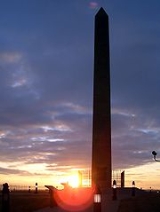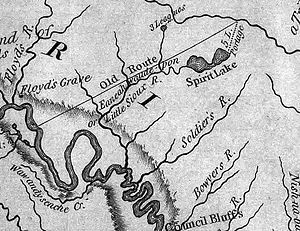
Sergeant Floyd Monument
Encyclopedia
The Sergeant Floyd Monument is a monument on the bank of the Missouri River
at Floyd's Bluff
in what is now Sioux City, Iowa
, USA. The monument honors Charles Floyd
, a member of the Lewis and Clark Expedition
, who died on the upstream voyage in 1804 and was buried here.
The monument is the first designated National Historic Landmark
of the United States.
Charles Floyd (1782 – 1804) was a United States explorer, a non-commissioned officer and quartermaster
in the Lewis and Clark Expedition
. A native of Kentucky
, he was a relative of William Clark. He was one of the first men to join the expedition.
While exploring the Louisiana Purchase
with Lewis and Clark, Floyd took ill at the end of July 1804. On July 31, Floyd wrote in his diary, "I am very sick and has been for sometime but have recovered my health again." However, this apparent recovery was soon followed by a severe turn for the worse. William Clark described his colleague's death as one "with a great deal of composure", and said that before Floyd died, he told Clark: "I am going away. I want you to write me a letter."
The expedition held a funeral and buried Floyd on a bluff overlooking the Missouri River
. They named it Floyd's Bluff in his honor.
Clark diagnosed Floyd's illness as bilious colic
, though modern doctors and historians agree Floyd's death was more likely to have been caused by a ruptured appendix
. The brief "recovery" Floyd described may have represented the temporary relief afforded by the bursting of the organ, which would have been followed by a fatal peritonitis
. Because there was no known cure for appendicitis
at that time, he could not have been saved by even the best physician
s of the day.
By 1857, erosion
had caused much of Floyd's grave—even the original cedar post marker left by the crew of the expedition—to slide into the river and wash away. Concerned citizens rescued most of his skeleton, including his skull, and re-buried it 200 meters east of the original burial site. A forensic reconstruction of Sgt. Floyd's probable facial appearance based on a plaster cast of his skull is on display at the Sergeant Floyd Riverboat Museum in Sioux City.
After Floyd's expedition journal was published in 1894, new interest was taken in him. His gravemarker was stolen by thieves. Floyd's remains were reinterred once more on August 20, 1895 with a monument. A marble cornerstone three feet wide and seven feet long was placed in 1900. When the obelisk of white sandstone standing 100 feet (30.5 m) high was completed on May 30, 1901, Floyd's grave was moved for the fourth time to rest nearby, where it remains to this day. In 1960, the monument was recognized by the U.S. Department of Interior as the first National Historic Landmark
. It was designated a National Historic Landmark
on June 30, 1960.
 The Floyd Monument is now within a 23 acres (93,077.8 m²) park that offers visitors a splendid view of the Missouri River valley. Floyd's final resting place is located on old U.S. Highway 75
The Floyd Monument is now within a 23 acres (93,077.8 m²) park that offers visitors a splendid view of the Missouri River valley. Floyd's final resting place is located on old U.S. Highway 75
, in the southern part of Sioux City, Iowa
.
Missouri River
The Missouri River flows through the central United States, and is a tributary of the Mississippi River. It is the longest river in North America and drains the third largest area, though only the thirteenth largest by discharge. The Missouri's watershed encompasses most of the American Great...
at Floyd's Bluff
Floyd's Bluff
Floyd's Bluff is a hill in southern Sioux City, Iowa that is named for Sergeant Charles Floyd.Floyd, who was the quartermaster for the Lewis and Clark Expedition's Corps of Discovery, was the only fatality during the expedition. The bluff was Floyd's original burial site in 1804, and is now the...
in what is now Sioux City, Iowa
Sioux City, Iowa
Sioux City is a city in Plymouth and Woodbury counties in the western part of the U.S. state of Iowa. The population was 82,684 in the 2010 census, a decline from 85,013 in the 2000 census, which makes it currently the fourth largest city in the state....
, USA. The monument honors Charles Floyd
Charles Floyd (explorer)
Charles Floyd was a United States explorer, a non-commissioned officer in the U.S. Army, and quartermaster in the Lewis and Clark Expedition. A native of Kentucky, he was a relative of William Clark, an uncle to the politician John Floyd, and a brother to James John Floyd...
, a member of the Lewis and Clark Expedition
Lewis and Clark Expedition
The Lewis and Clark Expedition, or ″Corps of Discovery Expedition" was the first transcontinental expedition to the Pacific Coast by the United States. Commissioned by President Thomas Jefferson and led by two Virginia-born veterans of Indian wars in the Ohio Valley, Meriwether Lewis and William...
, who died on the upstream voyage in 1804 and was buried here.
The monument is the first designated National Historic Landmark
National Historic Landmark
A National Historic Landmark is a building, site, structure, object, or district, that is officially recognized by the United States government for its historical significance...
of the United States.
Charles Floyd (1782 – 1804) was a United States explorer, a non-commissioned officer and quartermaster
Quartermaster
Quartermaster refers to two different military occupations depending on if the assigned unit is land based or naval.In land armies, especially US units, it is a term referring to either an individual soldier or a unit who specializes in distributing supplies and provisions to troops. The senior...
in the Lewis and Clark Expedition
Lewis and Clark Expedition
The Lewis and Clark Expedition, or ″Corps of Discovery Expedition" was the first transcontinental expedition to the Pacific Coast by the United States. Commissioned by President Thomas Jefferson and led by two Virginia-born veterans of Indian wars in the Ohio Valley, Meriwether Lewis and William...
. A native of Kentucky
Kentucky
The Commonwealth of Kentucky is a state located in the East Central United States of America. As classified by the United States Census Bureau, Kentucky is a Southern state, more specifically in the East South Central region. Kentucky is one of four U.S. states constituted as a commonwealth...
, he was a relative of William Clark. He was one of the first men to join the expedition.
While exploring the Louisiana Purchase
Louisiana Purchase
The Louisiana Purchase was the acquisition by the United States of America of of France's claim to the territory of Louisiana in 1803. The U.S...
with Lewis and Clark, Floyd took ill at the end of July 1804. On July 31, Floyd wrote in his diary, "I am very sick and has been for sometime but have recovered my health again." However, this apparent recovery was soon followed by a severe turn for the worse. William Clark described his colleague's death as one "with a great deal of composure", and said that before Floyd died, he told Clark: "I am going away. I want you to write me a letter."
The expedition held a funeral and buried Floyd on a bluff overlooking the Missouri River
Missouri River
The Missouri River flows through the central United States, and is a tributary of the Mississippi River. It is the longest river in North America and drains the third largest area, though only the thirteenth largest by discharge. The Missouri's watershed encompasses most of the American Great...
. They named it Floyd's Bluff in his honor.
Clark diagnosed Floyd's illness as bilious colic
Abdominal pain
Abdominal pain can be one of the symptoms associated with transient disorders or serious disease. Making a definitive diagnosis of the cause of abdominal pain can be difficult, because many diseases can result in this symptom. Abdominal pain is a common problem...
, though modern doctors and historians agree Floyd's death was more likely to have been caused by a ruptured appendix
Vermiform appendix
The appendix is a blind-ended tube connected to the cecum , from which it develops embryologically. The cecum is a pouchlike structure of the colon...
. The brief "recovery" Floyd described may have represented the temporary relief afforded by the bursting of the organ, which would have been followed by a fatal peritonitis
Peritonitis
Peritonitis is an inflammation of the peritoneum, the serous membrane that lines part of the abdominal cavity and viscera. Peritonitis may be localised or generalised, and may result from infection or from a non-infectious process.-Abdominal pain and tenderness:The main manifestations of...
. Because there was no known cure for appendicitis
Appendicitis
Appendicitis is a condition characterized by inflammation of the appendix. It is classified as a medical emergency and many cases require removal of the inflamed appendix, either by laparotomy or laparoscopy. Untreated, mortality is high, mainly because of the risk of rupture leading to...
at that time, he could not have been saved by even the best physician
Physician
A physician is a health care provider who practices the profession of medicine, which is concerned with promoting, maintaining or restoring human health through the study, diagnosis, and treatment of disease, injury and other physical and mental impairments...
s of the day.
By 1857, erosion
Erosion
Erosion is when materials are removed from the surface and changed into something else. It only works by hydraulic actions and transport of solids in the natural environment, and leads to the deposition of these materials elsewhere...
had caused much of Floyd's grave—even the original cedar post marker left by the crew of the expedition—to slide into the river and wash away. Concerned citizens rescued most of his skeleton, including his skull, and re-buried it 200 meters east of the original burial site. A forensic reconstruction of Sgt. Floyd's probable facial appearance based on a plaster cast of his skull is on display at the Sergeant Floyd Riverboat Museum in Sioux City.
After Floyd's expedition journal was published in 1894, new interest was taken in him. His gravemarker was stolen by thieves. Floyd's remains were reinterred once more on August 20, 1895 with a monument. A marble cornerstone three feet wide and seven feet long was placed in 1900. When the obelisk of white sandstone standing 100 feet (30.5 m) high was completed on May 30, 1901, Floyd's grave was moved for the fourth time to rest nearby, where it remains to this day. In 1960, the monument was recognized by the U.S. Department of Interior as the first National Historic Landmark
National Historic Landmark
A National Historic Landmark is a building, site, structure, object, or district, that is officially recognized by the United States government for its historical significance...
. It was designated a National Historic Landmark
National Historic Landmark
A National Historic Landmark is a building, site, structure, object, or district, that is officially recognized by the United States government for its historical significance...
on June 30, 1960.

U.S. Route 75
U.S. Route 75 is a north–south U.S. Highway. The highway's northern terminus is in Kittson County, Minnesota, at the Canadian border, where it continues as Manitoba Highway 75 on the other side of a closed border crossing. Its southern terminus is at Interstate 30 and Interstate 45 in Dallas,...
, in the southern part of Sioux City, Iowa
Iowa
Iowa is a state located in the Midwestern United States, an area often referred to as the "American Heartland". It derives its name from the Ioway people, one of the many American Indian tribes that occupied the state at the time of European exploration. Iowa was a part of the French colony of New...
.

